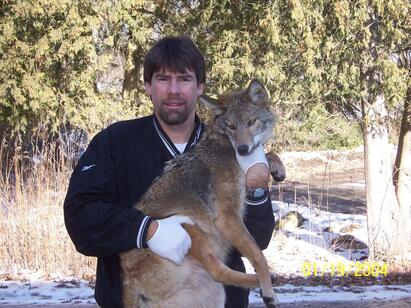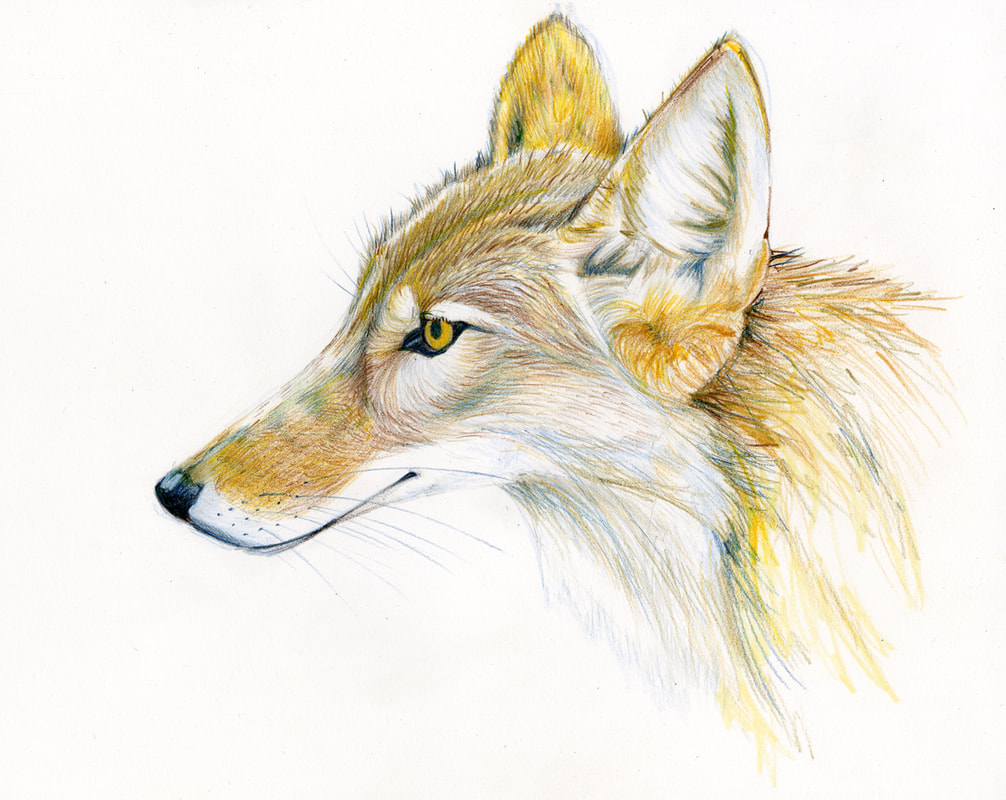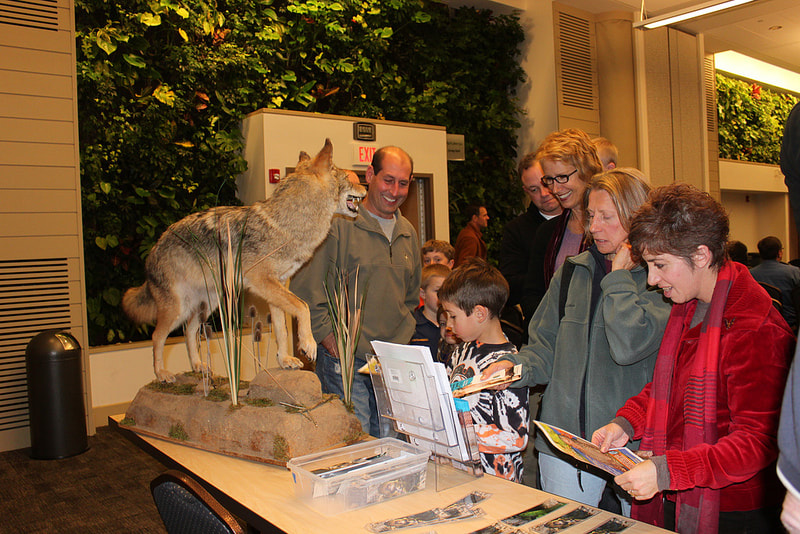 Stan Gehrt has been studying urban coyotes in Chicago since 2000. Photo courtesy of S. Gehrt Stan Gehrt has been studying urban coyotes in Chicago since 2000. Photo courtesy of S. Gehrt Do you hear coyotes howling at night? See them trotting down the sidewalk or crossing streets? Without a doubt, coyotes are active members of our North Shore communities. But, how much do we really understand this medium-sized member of the dog family (along with wolves and foxes)? Coyotes are often misunderstood, as well as underappreciated for the valuable role they are playing. Learning more about these elusive creatures is the best way for us to live harmoniously with coyotes. Coyotes, Canis latrans, are native to North America and currently occur throughout most of the continent. Their historical range prior to 1700 was restricted to the prairies and desert areas of Mexico and central North America. But over the past few centuries, coyotes have dramatically expanded their range across North America and now are found in an increasing number of cities in the United States and Canada. In addition to occurring in natural areas, coyotes are also found in a range of human-populated areas, including rural farms, suburbs and cities. Stan Gehrt, Ph.D., Associate Professor in the School of Environment and Natural Resources at Ohio State University, has been leading a team of researchers studying urban coyotes in the Chicago metropolitan region since 2000. Gehrt’s team has caught and marked 661 coyotes, including radio collaring 379. He recently shared fascinating facts about coyotes with 200 curious community members at the Greenbelt Cultural Center in North Chicago at an event sponsored by Friends of Ryerson Woods and Conserve Lake County. Here is a sampling of what Gehrt’s team has discovered about coyotes on our region: - Most adults weigh between 25-35 lbs. A few big ones weigh in the 42-43 lbs. range. There are no 50 lb. coyotes. - They have individual personalities. Some are shy, others aggressive. Some howl often, others hardly at all. Individual variation is tremendous. - Packs are made of family members and are very territorial. - Howling is a way to bring family members together, as well as to establish territory; it is not a sign of aggression or hunting. - Coyotes are monogamous for life; pairs only split upon the death of a mate. - The average litter size is 4-7 pups, although can range from 3-15. - Male coyotes help raise the young just as much as females. - February is the peak of mating season for coyotes; litters are born in April. - During mating and gestation is the only time coyotes will voluntarily use a den (a burrow in the ground or hollowed out tree); otherwise, coyotes usually sleep above ground in the open or in cover. - In captivity, coyotes can live 13 to 15 years, but in the wild, most die before they reach three years of age. Gehrt’s study found that coyotes generally have a 60 percent chance of surviving one year. - Coyotes inhabit virtually every green space of any significant size throughout the Chicago metropolitan region; if they are removed, new ones will move right in. - Coyotes in the Chicago metropolitan area confine most of their activity to nocturnal hours, whereas in natural areas, coyotes tend to be diurnal (active during the day) or crepuscular (active at dawn and dusk). This reduces the likelihood of interacting with humans. - Coyotes are incredibly adaptable. Gehrt showed video of coyotes crossing city streets and even interstates safely, apparently looking both ways before crossing the street and following green lights. Much controversy revolves around what coyotes eat. Gehrt’s study has provided fascinating information, including some unexpected results. A study of coyote scat (poop) revealed that the most common food items are small rodents (42 percent), fruit (23 percent), deer (22 percent), and rabbit (18 percent). They also will eat birds, frogs, skunks, insects and the occasional beaver or muskrat. Apparently the majority of coyotes in the region do not, in fact, rely on our pets (1%) or garbage (2%) for their diets. (Scats often have more than one diet item; therefore, frequencies do not necessarily add up to 100 percent). As coyotes need to eat about 10% of their body weight each day, this preference for rodents can result in a diet of 3,000 rodents per year! Further, coyotes serve as the primary predators on fawns. One surprising find was that coyotes control Canada Geese populations by eating the eggs. Geese parents can fight off raccoons but not coyotes. 97% of goose nest predation is carried out by coyotes. Geese and deer are often overabundant and difficult to manage. Thus, coyotes play a key role in naturally controlling rodent, deer and geese populations. But, what about our pets? There are a few things to consider. It is natural canid (dog family) behavior to kill smaller canids. This is about instinct and survival. Given the opportunity, wolves will kill coyotes, coyotes will kill fox, and so on. This is less about getting a meal, but instead about eliminating competition. So, you want to keep an eye on your small dogs. Coyotes also may kill domestic cats for food or again to eliminate competition, but Gehrt’s study reveals that cats make up a very small part of their diet. Also, other predators eat cats, including Great Horned Owls. If coyotes live nearby, do not let pets run loose, especially domestic cats. When hiking in preserves, keep dogs on leashes.
FIVE EASY STEPS TO AVOID CONFLICTS WITH COYOTES
Conflicts with coyotes can be avoided by taking simple precautions or by altering behaviors to avoid confrontation: 1. Do not feed the coyotes. 2. Do not let pets run loose. 3. Do not run from a coyote. 4. Repellents or fencing may help. 5. Report aggressive, fearless coyotes immediately. To learn more about the Cook County Coyote Project, visit www.urbancoyoteresearch.com.
0 Comments
|
AuthorThis blog is written by the staff and partners of Brushwood Center at Ryerson Woods Archives
February 2022
Categories |
|
21850 N. Riverwoods Rd.
Riverwoods, IL 60015 224.633.2424 [email protected] ABOUT BRUSHWOOD BECOME A PARTNER VOLUNTEER AND JOB OPPORTUNITIES |
Brushwood Center at Ryerson Woods is committed to enabling the participation and enjoyment of our programming and events for all visitors. At Brushwood Center, you will have open access to accessible parking and entrance to the house, a gender neutral bathroom, and changing tables.
If you require certain accommodations in order to observe or attend our events, or have questions regarding accessibility of our facilities, please contact our Director of Public Programs and Music, Parker Nelson, at [email protected] or at (224) 633-2424 ext. 1. Programming and events at Brushwood Center are available to everyone, including but not limited to age, disability, gender, marital status, national origin, race, religion, and sexual orientation. Site Photography by: In Life Photography, Michael Kardas Photography, Ewa Pasek Photography, Brushwood Staff, and Josiah Shaw Productions |
OPEN TO THE PUBLIC Monday - Thursday & Saturday: 10am - 3pm Sunday: 1pm - 3pm and by appointment |


 RSS Feed
RSS Feed
